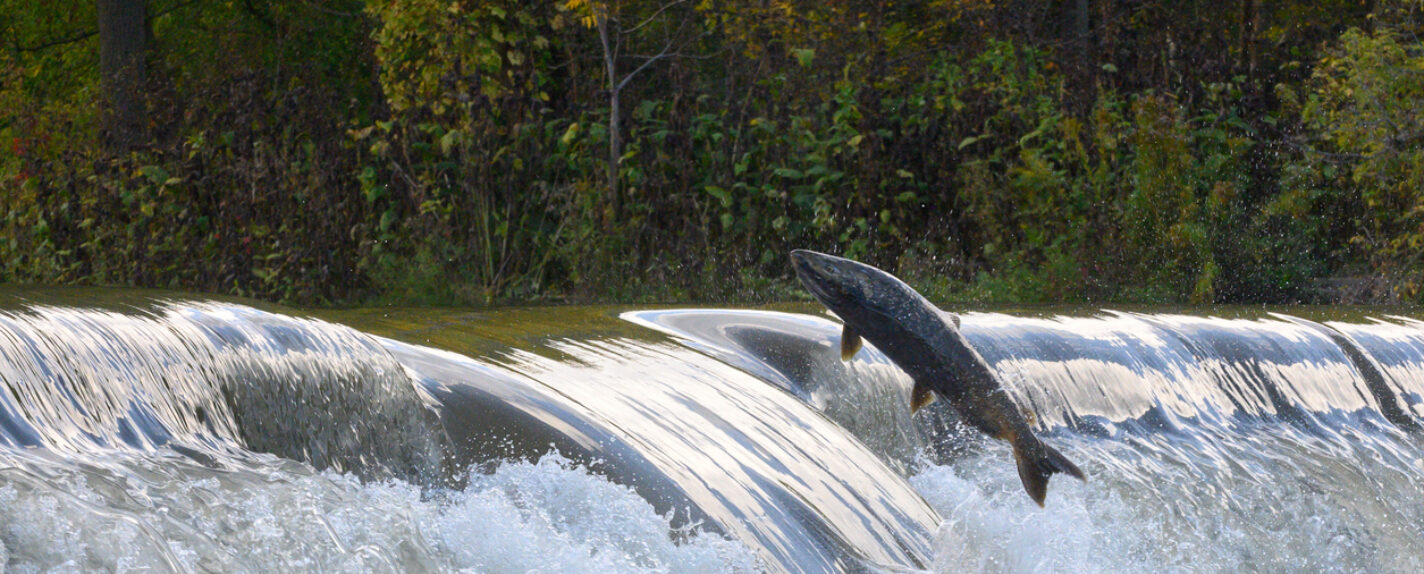US Withdraws from Columbia River ESA Settlement

Newsletter Articles
A multi-year effort that temporarily settled the country’s longest-running natural resource litigation is unraveling. The case, involving the effects of Columbia River Hydropower System operations (CRSO) on various salmon stocks listed under the Endangered Species Act (ESA), pits Washington and Oregon, along with several Indian Tribes and environmental groups, against the U.S. Army Corps of Engineers and Bureau of Reclamation, parties who rely on the hydropower and other benefits the 14 dams that make up the system provide, and the states of Idaho and Montana.[i] In 2023 the Biden Administration reached a Memorandum of Understanding (MOU) with Plaintiffs in the case called the “Resilient Columbia Basin Agreement" (RCBA) under which the United States committed to invest $1 billion toward salmon restoration and related efforts in exchange for up to a ten-year stay of the litigation.[ii] On June 12, 2025, however, President Trump ordered federal agencies with jurisdiction over CRSO and marketing of the hydropower it generates to withdraw from the RCBA.[iii] The upshot of the U.S. withdrawal from the MOU is that the 25-year-old litigation will likely be reactivated after nearly a four-year hiatus,[iv] although no action has been taken in the case to lift the pending stay as yet.
The crux of the RCBA consists of a series of 10-year commitments the United States made in response to the “Columbia Basin Restoration Initiative” (CBRI)[v] that Oregon, Washington, and four tribal nations developed as a proposed comprehensive strategy to restore fish populations affected by CRSO. These commitments include more than $1 billion in investments for various facets of salmon recovery as well as multiple studies to explore potential options for replacement of the hydropower and other valuable resources that would be forgone if the four Lower Snake dams that form a part of the system were breached. The principal rationale the President offered for withdrawing from the MOU is its commitment to an in-depth exploration of breaching the Lower Snake dams and the negative effects he cited that would result from such action.[vi]
Background of Resilient Columbia Basin Agreement
Litigation involving impacts of CRSO on ESA-listed salmonids dates back more than three decades, since shortly after the first stocks affected by system operations were listed under the ESA in 1991. The current case, the initial phase of which challenged a long-since superseded Biological Opinion of the National Marine Fisheries Service (NMFS) on the effects of CRSO on listed salmonids, has been pending nearly a quarter-century, since 2001.
The most recent round[vii] of active litigation in the current case involved consolidated challenges a series of environmental groups, Oregon, Washington, and several tribal nations brought against decisions the U.S. Army Corps of Engineers and Bureau of Reclamation made to govern CRSO at the tail end of President Trump’s first term. Plaintiffs’ claims attacked the validity of the Environmental Impact Statement those agencies prepared to analyze the environmental effects of their CRSO decisions under the National Environmental Policy Act (NEPA) as well as the Biological Opinions the U.S. Fish & Wildlife Service and NMFS issued on such operations. The EIS was groundbreaking in several respects, first because it was the first one federal agencies had prepared to evaluate CRSO and also because it analyzed in detail an alternative to breach the Lower Snake dams.[viii] Shortly after Plaintiffs filed a motion for preliminary injunction, the district court granted the first of a series of motions seeking episodic stays of the proceedings to allow the parties to pursue mediated discussions designed to resolve Plaintiffs’ claims.
As the last of these shorter-term stays neared expiration, several developments unfolded that led to development and execution of the RCBA:
• In Sept. 2023, the U.S. entered into an agreement with the Coeur d’Alene Tribe, Confederated Tribes of the Colville Reservation, and Spokane Tribe of Indians to support a Tribal-led effort to restore salmon to their long-blocked habitat in the Upper Columbia River Basin above Chief Joseph and Grand Coulee Dams, including BPA’s commitment to devote $200 million over a 20-year period to help fund a salmon reintroduction plan of the Upper Columbia United Tribes;[ix]
• Also in Sept. 2023, President Biden issued his own Presidential Memorandum on Restoring Healthy and Abundant Salmon, Steelhead, and Other Native Fish Populations in the Columbia River Basin.[x] It directed relevant federal agencies to work collaboratively with Congress and Tribal Nations, states, local governments, and stakeholders to, among other things, restore healthy and abundant salmon, steelhead, and other native fish populations to the Basin;
• In the fall of 2023, the Confederated Tribes and Bands of the Yakama Nation, Confederated Tribes of the Umatilla Indian Reservation, Confederated Tribes of the Warm Springs Reservation of Oregon, Nez Perce Tribe, and the States of Oregon and Washington (the self-styled “Six Sovereigns”) provided the CBRI to the U.S. as a proposal for restoring salmon runs in the basin that explicitly calls for breaching the four Lower Snake dams;
• The U.S. responded to the CBRI by issuing its Commitments in Support of the CBRI (USG Commitments),[xi] which includes a 10-year interim operations strategy (covering 2024-2033) for the four lower Snake River and four lower Columbia River dams, the pursuit of more than $1 billion in funding for various salmon recovery projects, and a series of proactive efforts to identify replacement resources for the hydropower and other benefits that would be lost to the region if the Lower Snake dams were breached;
• In Dec. 2023, predicated on the USG Commitments, Plaintiffs in NWF v. NMFS entered into an MOU with the federal government pursuant to which Federal Defendants agreed to implement those commitments in exchange for Plaintiffs’ agreement to forgo litigating their claims for up to ten years, to be effectuated via two successive motions to stay the case for five-year increments;
• The parties to the MOU followed up by moving for the first of the five-year stays seeking to stay the litigation through the end of 2028, which the Court granted over the objections of several parties who were not privy to or involved in development of the CBRI, MOU, or RCBA, including the states of Idaho and Montana, the Public Power Council, Inland Navigation Ports Group, and Northwest River Partners.
The order granting the stay directed the moving parties to update the district court annually on their progress in implementing the USG Commitments consistent with the MOU, the first of which they filed in January of this year. In that Joint Status Report, the moving parties simply reported that they were continuing to implement those commitments as reflected on a webpage that offers updates on MOU implementation.[xii]
Shortly before President Biden left office, the Army Corps of Engineers and Bureau of Reclamation issued a Notice of Intent to prepare a Supplemental Environmental Impact Statement (SEIS) to update the CRSO EIS issued in Sept. 2020 to account for the RCBA and other developments that have occurred in the interim.[xiii]
Presidential Memorandum Withdrawing from RCBA & Reversing Its Implementation
The MOU contains a provision authorizing any party to withdraw from the agreement after providing written notice to other parties under one of three conditions: (1) after exhausting dispute resolution processes prescribed in the MOU; (2) after conferring with the other parties during a 90-day conferral window leading up to the expiration of the first five-year stay period; or (3) in the event of litigation either seeking to revive Plaintiffs’ stayed claims in the current litigation, or challenging environmental compliance for CRSO actions taken to implement the USG Commitments. The first criterion appears to be the only one of the three the United States would presently be able to invoke to pursue withdrawal from the RCBA MOU. That dispute resolution criterion first requires raising a formal “point of disagreement” that initiates the prescribed dispute resolution processes. Ultimately, however, if any party to the MOU provides notice to the others that formal dispute resolution has been unsuccessful, or the parties unanimously agree to bypass all or part of the specified formal dispute resolution procedures, a party ultimately has authority to withdraw from the MOU, including the United States.
The new Presidential Memorandum calls for the relevant federal agencies to “take all appropriate steps to withdraw” from the MOU within 15 days, or by June 27, 2025. It further directs such agencies to rescind the December 2024 Notice of Intent to prepare the SEIS the Biden Administration announced the action agencies would prepare. In its place, the Secretaries are directed to craft a schedule for completion of a differently focused SEIS in accordance with the recent NEPA developments that have occurred under the new Administration. The Secretaries are to submit that schedule to the Chair of the Council on Environmental Quality (CEQ) as well as reports on (1) any actions relevant federal agencies have taken pursuant to the CRSO-related Presidential Memorandum President Biden issued in Sept. 2023; (2) the status of all commitments made pursuant to that presidential memorandum; (3) any steps that may be taken to rescind federal funds obligated to implement the RCBA MOU; and (4) the actions that are being taken to withdraw from the MOU. These reports are due to be submitted by July 12, 2025.
The new Presidential Memorandum can thus be seen primarily as an attempt to undo the architecture and funding the Biden Administration developed and committed to effectuate and to instead restore CRSO to the strategy adopted in Sept. 2020 during the Trump Administration’s first term. This can be expected to revive the litigation over those operations that have already occupied more than three decades.
We will keep track of these developments closely. For more information, please contact Steve Odell in Marten’s Oregon office, Albert Barker in Idaho, or James Tupper in Washington.
[i] National Wildlife Federation v. National Marine Fisheries Service, 3:01-cv-640-SI (D. Or.).
[ii] Memorandum of Understanding (Dec. 14, 2023) (available at https://critfc.org/wp-content/uploads/2024/02/CBRI-MOU.pdf). Under the terms of the MOU, the pending five-year stay is subject to renewal for another five-year increment if all parties to the MOU believe adequate progress is being made to work in partnership on Columbia River Basin restoration pursuant to the RCBA and no parties withdraw from the MOU.
[iii] The White House, “Stopping Radical Environmentalism to Generate Power for the Columbia River Basin,” Pres. Memo. (June 12, 2025) (available at https://www.whitehouse.gov/presidential-actions/2025/06/stopping-radical-environmentalism-to-generate-power-for-the-columbia-river-basin/).
[iv] T. Schick, “Trump upends historic Columbia River Basin agreement, bringing uncertainty to salmon recovery efforts,” Oregon Public Broadcasting website (June 12, 2025)(quoting Plaintiffs’ counsel as stating that basis for stay no longer exists) (available at https://www.opb.org/article/2025/06/12/trump-upends-columbia-river-basin-agreement/).
[v] https://critfc.org/wp-content/uploads/2024/02/CBRI-overview.pdf.
[vi] In Aug. 2022, Sen. Patty Murray and Washington Gov. Inslee published a report summarizing their views as to what would be required to replace the benefits the Lower Snake Dams provide to the region (available at https://governor.wa.gov/sites/default/files/2022-11/LSRD%20Benefit%20Replacement%20Final%20Report_August%202022.pdf).
[vii] All told, including the current round there have been five rounds of litigation in the pending case alone focusing principally on the validity of the various Biological Opinions NMFS has issued over the past 24 years to evaluate CRSO’s effects on listed salmonid stocks for compliance with the ESA. The courts have found every one of those previous Biological Opinions (BiOps) legally deficient in one or more particulars. NWF v. NMFS, 254 F. Supp. 2d 1196 (D. Or. 2003) (2000 BiOp); NWF v. NMFS, 2005 WL 1278878 (May 26, 2005), aff’d, 524 F.3d 917 (9th Cir. 2008) (2004 BiOp); NWF v. NMFS, 839 F. Supp. 2d 1117 (D. Or.2011) (2010 Supplemental BiOp to 2008 BiOp); NWF v. NMFS, 184 F. Supp. 3d 861 (D. Or. 2016), appeal dismissed, 2016 WL 9631334 (9th Cir. Dec. 20, 2016) (2014 BiOp).
[viii] For more details on the EIS, see Marten’s previous newsletter article, “Final Columbia River EIS Considers Breaching Four Lower Snake River Dams" (Sept. 18, 2020) (https://martenlaw.com/news/final_columbia_river_eis_considers_breaching_four_lower_snake_river_dams).
[ix] USDOI Media Release, “Biden-Harris Administration, Tribes Reach Historic Agreement Supporting Efforts to Restore Healthy and Abundant Salmon Populations to Upper Columbia River Basin” (Sept. 21, 2023) (archived version at https://www.doi.gov/pressreleases/biden-harris-administration-tribes-reach-historic-agreement-supporting-efforts-restore#:~:text=WASHINGTON%20%E2%80%94%20The%20Biden-Harris%20administration,the%20Upper%20Columbia%20River%20Basin).
[x] The White House, “Presidential Memorandum on Restoring Healthy and Abundant Salmon, Steelhead, & Other Native Fish Populations in the Columbia River Basin” (Sept. 27, 2023) (available at https://bidenwhitehouse.archives.gov/briefing-room/presidential-actions/2023/09/27/memorandum-on-restoring-healthy-and-abundant-salmon-steelhead-and-other-native-fish-populations-in-the-columbia-river-basin/).
[xi] U.S. Government Commitments in Support of the “Columbia Basin Restoration Initiative” and in Partnership with the Six Sovereigns (available at https://critfc.org/wp-content/uploads/2024/02/USG-Commitments-toCBRI.pdf).
[xii] https://salmonrecovery.gov/crtf.html.
[xiii] U.S. Army Corps of Engineers & Bureau of Reclamation, Notice of Intent to Prepare a Supplemental Environmental Impact Statement for the Columbia River System Operations, 89 Fed. Reg. 102,869 (Dec. 18, 2024) (available at https://www.govinfo.gov/content/pkg/FR-2024-12-18/pdf/2024-29936.pdf).
Newsletter Articles
Authors
Related Services and Industries
Authors
Related Services and Industries
Stay Informed
Sign up for our law and policy newsletter to receive email alerts and in-depth articles on recent developments and cutting-edge debates within our core practice areas.


